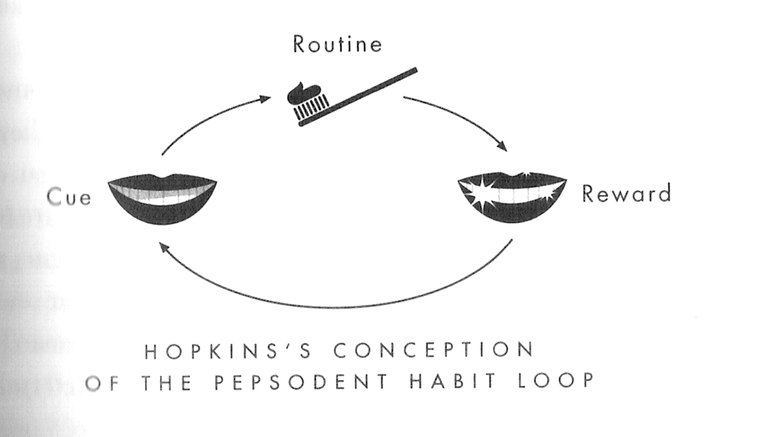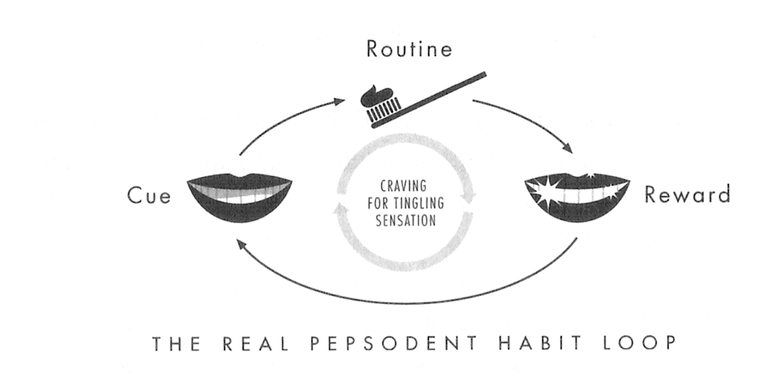Marketing Monday—Pepsodent's Habit Loop
As promised, this week's Marketing Monday post will dive into The Power of Habit by Charles Duhigg.
My intent in doing so is to present ideas that could be used by anyone to form a marketing campaign for STEEM. It's not meant to take the place of, or take precedence over any existing or emerging marketing campaign out there. I'm mostly interested in making marketing more top of mind than what it's been, give some kind of framework and thought to what has worked with other products/services, and see where any of that goes.
The Power Of Habit
I highly recommend reading The Power of Habit for anyone who has a general interest in knowing how habits are formed. The book delves into a few case studies that aren't directly associated with marketing, but act as a foundation for creating marketing plans.
Thus, the main premise of the book is that in order to effectively market anything, one first must have a decent grasp on what motivates people to consume, and keep consuming. In order for that to happen, a habit must be formed, and more specifically, a habit loop.

100 Hundred Years Ago...
This might be hard to conceive of today, but in the earlier part of the 20th Century, dental hygiene was virtually nonexistent, at least in the United States. It was so bad, that there were quite a few otherwise healthy men who were not allowed to join the military during WWI due to their rotting teeth.
This was despite the prevalence of tooth brushes, pastes and powders, and numerous attempts by the medical community to convince the public it should brush its teeth.
The companies of toothpaste and powder in particular tried all kinds of persuasion in their advertising, but nothing worked. Nothing, that is, until Charles C. Hopkins, a giant in the world of advertising at the time, finally relented and began researching ways to market Pepsodent.

Now, Pepsodent was one of many toothpaste/powders out there, and wasn't that much different from them. In fact, the main reason why Hopkins decided to take Pepsodent on at all is because of a good friend he had known for years had been begging him to do it. Because of his friend's persistence, Hopkins finally acquiesced, and went about the task of figuring out a marketing strategy.
Hopkins had discovered prior to this that there needed to be a catalyst for people to buy things. He became quite good at selling all kinds of products (Quaker Oats, Palmolive, Schlitz Beer, Puffed Wheat, Goodyear tires, etc.) through a method he continually perfected—Scientific Advertising (and authored a book about it). Essentially, he did market research before it was a thing. He would try different ideas, track how they did, and if they didn't respond within a short period of time (often a week), he would try something else.
Eventually, he was able to get to what worked faster by relying on the knowledge he gained about human nature and what really motivated people.
In the case of Pepsodent, he was well aware of what others had tried to do. Hygiene and health was not the way to go, especially in a negative way. People didn't respond to that. What they were more apt to respond to, though, were appeals to their vanity. Both men and women responded to things that might make them more attractive, and so Hopkins settled on advertising that promised whiter teeth with Pepsodent.
Hopkins' Idea Of The Pepsodent Habit Loop
The image above shows basically what Hopkins was attempting to do. His ads instructed people to use their tongue to feel the film that had formed on their teeth. In doing so, that became their cue to do something—brush them, using Pepsodent. The reward, then, was after brushing, they would have whiter teeth.
And it worked. Within no time, Pepsodent went from an also ran brand, to an international sensation. It happened so quickly, the company had a hard time keeping up with demand. It remained the best selling toothpaste for over three decades.

Here's the deal, though.
As I mentioned earlier, the other toothpaste companies had tried all kinds of ideas to market their pastes and powders. Focusing on the film and the beautification aspects of brushing was not at all new by the time Hopkins jumped into the ring. These other marketing strategies had failed, however. Why?
Pepsodent Tingled
Pepsodent's cleaning ingredients were virtually the same as the other brands. However, it did have a few things the others did not. Among them, citric acid and mint oil. So, the gums were irritated, or tingled, and then there was this minty taste that consumers quickly associated with cleanliness.
Pepsodent had stumbled upon the actual reason for brushing quite by accident. Even if people brushed, they didn't know if the paste they were using was actually doing anything. They might not be able to see that their teeth were gradually getting whiter, because the results took time. They had no way in the interim of knowing if their teeth were actually clean, other than no longer feeling the film there.
While it had absolutely nothing to do with it, the citric acid and the mint oil became associated with cleanliness, and it was something the felt good. And the tingling was immediate and satisfying. These chemicals, in other words, created the craving for Pepsodent.

So, in reality, the habit loop that Hopkins envisioned was missing the craving part. He managed to get lucky because Pepsodent had the extra ingredients. However, the cue and routine parts were basically the same, even though the reward of whiter, prettier, healthier teeth was actually eclipsed by the craving for the tingling sensation Pepsodent provided.
It took a while, but the other toothpastes finally figured it out, added the extra chemicals for the tingling, and the rest, as they say, is history.
STEEM'S TINGLING SENSATION
What is it about STEEM that people crave? It probably won't be what initially brings them to it. It will be what keeps bringing them back, though, regardless of price, on STEEM shenanigans, rewards, or lack thereof, etc.
Next week, we'll take a look at possibilities.
Images sources—Pixabay and The Power of Habit
You have been curated by @yousafharoonkhan on behalf of Inner Blocks: a community encouraging first hand content, with each individual living their best life, and being responsible for their own well being. #innerblocks Check it out at @innerblocks for the latest information and community updates, or to show your support via delegation.
This post was shared in the Curation Collective Discord community for curators, and upvoted and resteemed by the @c-squared community account after manual review.
@c-squared runs a community witness. Please consider using one of your witness votes on us here
Love that book. I’ve read it twice and will eventually revisit it I’m sure.
Hey, @bryan-imhoff.
I found it very eye opening on a couple levels, both personally, and as a would be marketer. It's amazing how people a century ago were able to essentially stumble into these things without all the endless studies and information about human behavior that exploded during last century, especially the last half.
And maybe it did so because of these folks. There are iconic companies and products that we know and buy because of these efforts. How many more products do we not know, or will never see, because there's no real marketing strategy behind them? Let's not keep STEEM on that list.
Listen, people, you can have whiter teeth if you read my new Wordpress blog! :D
_^_^_^_
Hey, @deathcross.leo.
Okay, but they're still going to crave the tingle. Does your blog tingle? :)